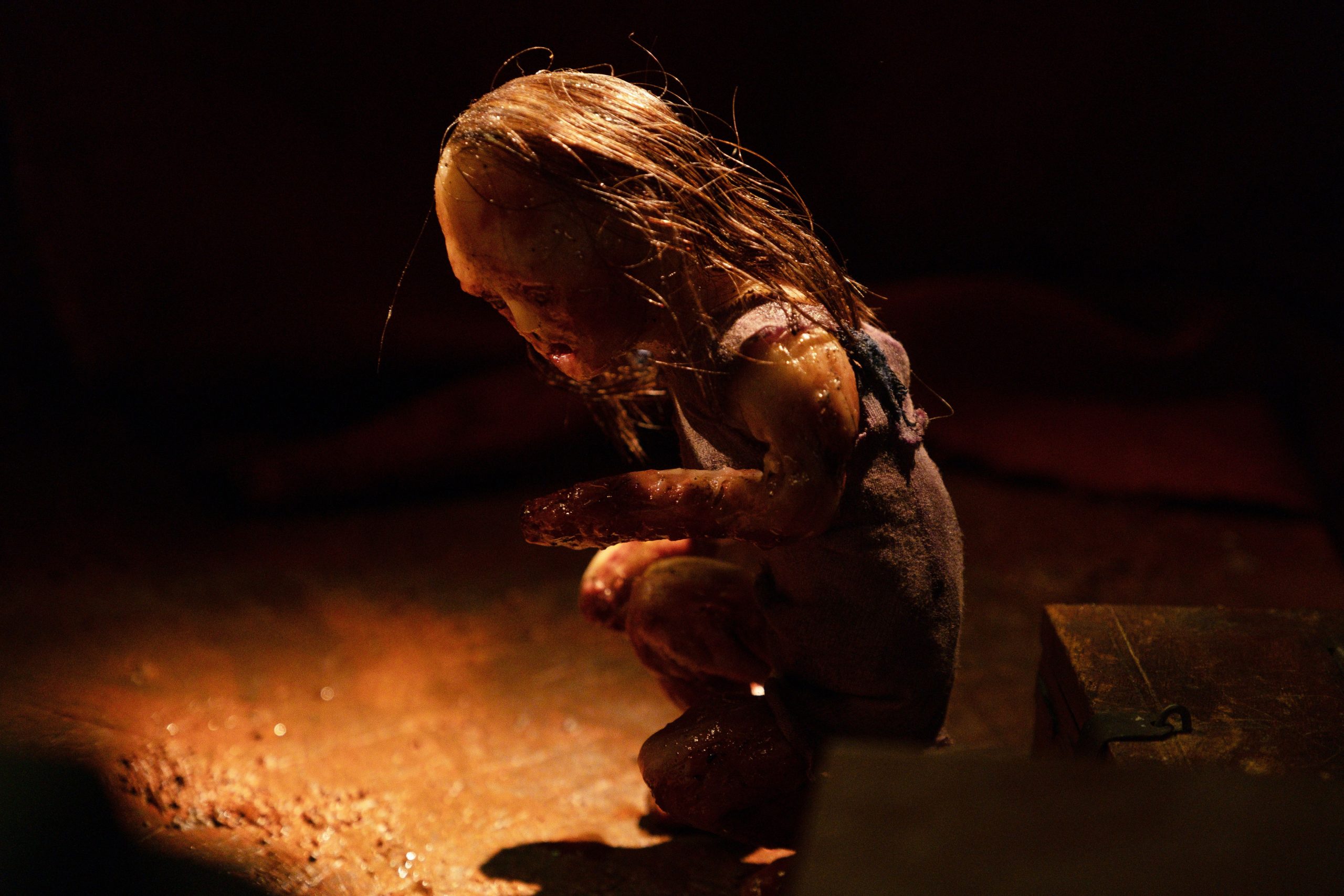After a long spell where horror films barely scratched the surface, horror fans can now breathe easier as a fresh wave of creative spins on classic styles is beginning to catch fire.
Stopmotion stands as shining evidence that true artistry, given the right chance, can deliver something special, especially with talents like Robert Morgan taking the reins.
Morgan’s earlier works, The Cat With Hands and Bobby Yeah, brilliantly show his mastery in blending stop-motion techniques with the horror genre that suits it so naturally.

In Stopmotion, Morgan weaves a story that leans heavily into Cronenberg-style body horror, diving deep into the dangers of chasing artistic perfection under intense mental strain, with his animation breathing life through the character of Ella.
What happens in the film?
Living under the shadow of a famous parent can already be a burden, but when mixed with emotional abuse, it leaves scars that run deep, as seen through Ella’s life. Her mother controls her with the same cold precision she uses on her animated characters, especially now that arthritis has left her unable to animate herself, pushing Ella to handle the puppetry for her cyclops project.
As Suzanne’s physical abilities fade, she clamps down even harder on Ella’s freedom, dictating every step she takes. Fear dictates Ella’s life so much that she even sneaks back home from a date before her mother notices her absence.
Adulthood, with all its promises, feels far out of reach for Ella. So deeply ingrained is her fear of disappointing her mother that when Suzanne falls into a coma, Ella automatically dedicates herself to completing her unfinished film.
How did Ella lose control of herself?
From the onset, Stopmotion presents scenes hinting at Ella’s eventual descent into mental darkness while also showing her mind’s gradual collapse. Despite her deep belief in her gift to infuse puppets with life, Ella never had the freedom to truly express her own creativity.
Instead, her mother’s strict demands for perfection consumed every bit of her artistic spirit. Given how Suzanne never paused to consider Ella’s exhaustion, it becomes clear that Ella’s well-being was never a concern. Growing up under such suffocating conditions has left Ella burdened with crippling insecurity and self-doubt.
But her troubles don’t stop there. Ella struggles fiercely with a hollow creative spirit, desperately yearning to find a story of her own that might finally validate her.
From the very first scenes, it’s obvious that Ella’s mind is fragile; the flickering lights capture the sudden changes in her expression, where darkness seems to win more often than light. As her perception of reality starts to blur, she sees her mother’s body as a broken, fleshly puppet—a grotesque muse for her art.
Even with Suzanne in a coma, Ella remains haunted by the overwhelming fear of failure. Determined to see the film through, she accepts Tom’s offer to use his studio apartment as her workspace.
Is the Little Girl Ella herself?
While it’s understandable for a young admirer to seek inspiration from a mentor, Ella’s encounter with the Little Girl turns unsettling quickly. The girl criticizes her mother’s film and encourages Ella to create a new story, one about a girl being chased through a forest. Initially, it feels like Ella is finally finding her voice.
However, when the Little Girl insists she build puppets from mortician’s wax—used to patch dead bodies—the line between creativity and madness begins to blur.
Even more disturbing, Ella soon agrees to craft a second puppet using raw meat. Her easy submission stems from years of conditioning, always needing someone to command her steps now that her mother is absent.
When a person finally gains freedom after years of suppression, they often struggle to know what to do with it. Ella cannot fathom creating or even existing without external direction. This is something she openly admits when speaking to her comatose mother.
Yet, despite being aware of her dependency, the moments when she clicks her remote to animate grotesque scenes are the most alive she’s felt in years. Though Ella attempts to resist the Little Girl’s influence when asked to use a fox carcass for another puppet, self-doubt overwhelms her. Without the Little Girl feeding her ideas, Ella feels creatively paralyzed.
The disturbing pattern mirrors her childhood experience when she couldn’t voice her ideas under her mother’s pressure. At a party, this theme resurfaces; Ella, entranced by a talking puppet, hallucinates herself poking into an open wound on a man’s body. Watching closely reveals that the Little Girl is controlling Ella’s actions, steering her into acts she would never commit otherwise.
Stopmotion leaves many hints that the Little Girl represents a fractured part of Ella’s psyche. The fact that Polly, Tom’s sister, walks past the Little Girl without reacting shows she isn’t real. Years of suppressing her creativity have birthed a dangerous, impulsive presence inside Ella, urging her toward madness.
This theme becomes even more evident when the Little Girl records herself, and during playback, it’s Ella’s voice that plays, confirming that the Little Girl embodies a bolder version of herself.
If the Little Girl were real, she wouldn’t have appeared at multiple locations, including the hospital where Suzanne died and a restaurant toilet. With her lifelong puppeteer now incapacitated, Ella’s mind clutches onto a new one to survive the void.
Does Ella undergo psychosis?
Ella’s mental state shatters into uncontrollable pieces. As she throws herself deeper into the twisted story about the girl in the forest, reality and imagination mix until she loses her sense of time. She has no memory of building parts of her set with natural debris. Shock follows when she notices she has filmed scenes of a creature, the Ash Man, lurking outside a window.

The chilling idea is that whatever happens to the girl in the Little Girl’s story becomes real for Ella too. When the Ash Man is said to spy on the girl, Ella experiences real terror when a monstrous figure peers at her through her apartment’s peephole.
The film cleverly tricks viewers during the party scene where Ella supposedly takes drugs from Polly. However, Ella’s downward spiral isn’t drug-induced; she was fully sober when she decided to use decaying fox flesh to complete the Ash Man figure.
Ella is painfully aware of how reality is slipping, and she grows more agitated as the sound of her camera clicks matches the shrill buzzing of her landline phone. In her hallucinations, her comatose mother mocks her failures, pointing out the madness she cannot control. Although riddled with anxiety, Ella struggles to finish the project she believes she must complete.
As much as she recognises that her creation is consuming her, Ella cannot find an exit. She puts up a brave fight against the Little Girl’s suggestions and even tries altering the forest story so her puppet character escapes the Ash Man.
Despite her effort to take back control, Ella’s mind has already crumbled. Like the deep-rooted trauma she never escaped, the Ash Man—now life-sized—emerges from her tiny set to claim her. There is a strong argument that the Ash Man represents Ella’s repressed trauma.
The parallel between seeing herself as a helpless puppet and the terrifying Ash Man hints at childhood coping mechanisms to survive abuse. Sadly, Ella has sunk too deep to be pulled out.
Even after trying to rebuild her life by joining Polly’s stop-motion ad company, she discovers that Polly has stolen and commercialized her story. Things only grow darker for Ella, as hope slips further from her grasp.



